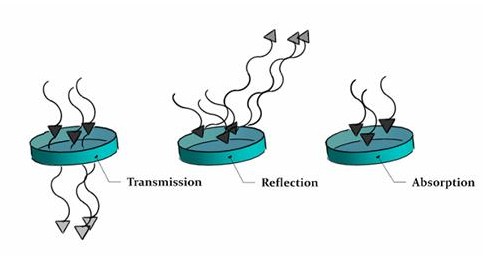www.fluorescencemicroscopy.it
Main menu:
- Home Page
- Microscopes
- Fluorescence
- Description
- Diascopy
- Epi-Fluoresc.
- Illumination
- Installing and Aligning a Mercury Lamp
- Fluorocromes
- Tables of Fluorocromes
- The Fading
- Wavelengths
- Properties
- % of transmission
- Types of filters
- Overlapping Spectra
- Intensity
- Image acquisition
- The Filter's set
- The Filters
- Fluorochrome's praparation
- Sample's preparations
- Fluorescence Sample
- Cytochemical Fluorescence
- Intrinsic Fluorescence
- Gallery
- Phase Contrast
- Polarization
- Darkfield
- DIC
- COL
- Rheinberg
- Brightfield
Properties
Fluorescence
Transmission, reflection and absorption
When light strikes a discontinuity in the medium through which it propagates, the wavelengths that pass through are called "transmitted", those that do not pass "blocked or attenuated." When working with the fluorescence, optical filters are used as discontinuities, these can be used to selectively block or transmit certain wavelengths. The block (or attenuation) can be achieved by reflecting or absorbing light from the filter and the degree to which a filter transmits or attenuates the light is totally dependent on its constituent material and the way they are used in its construction

A rainbow seen through a prism, for example, is a spectrum of transmitted light. It is a display of the wavelengths of light that the material was not able to attenuate (absorb or reflect).Transmission, reflection and absorption properties are all measurable and are used to quantify the ways in which the materials interact with light. The figure above shows visually the basic principles of transmission, reflection and absorption.
Sub-Menu:
- Description
- Diascopy
- Epi-Fluoresc.
- Illumination
- Installing and Aligning a Mercury Lamp
- Fluorocromes
- Tables of Fluorocromes
- The Fading
- Wavelengths
- Properties ←
- % of transmission
- Types of filters
- Overlapping Spectra
- Intensity
- Image acquisition
- The Filter's set
- The Filters
- Fluorochrome's praparation
- Sample's preparations
- Fluorescence Sample
- Cytochemical Fluorescence
- Intrinsic Fluorescence
- Gallery